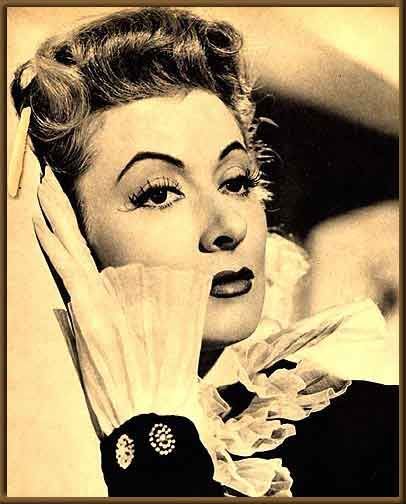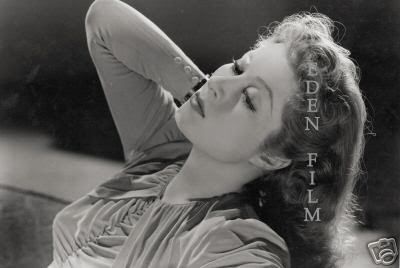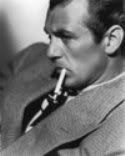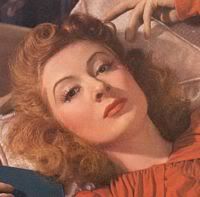Post by butterscotchgreer on Jun 22, 2007 10:44:41 GMT -5
Date of Birth
29 September 1904, London, England, UK
Date of Death
6 April 1996, Dallas, Texas, USA. (heart failure)
Birth Name
Eileen Evelyn Greer Garson
Nickname
Duchess
Height
5' 6" (1.68 m)
Mini Biography
Greer Garson was born in London, England, on September 29, 1904. Her childhood was a normal if not non-descript life. Greer showed no early signs of interest in becoming an actress. She was educated at the University of London with the intentions of becoming a teacher. Instead she opted to work with an advertising agency. During this time she appeared in local theatrical productions gaining a reputation as an extremely talented actress. She was discovered by Louis B. Mayer while he was on a visit to London looking for new talent. Greer was signed to a contract with MGM and appeared in her first American film in 1939. The movie in question was Goodbye, Mr. Chips (1939) which won rave reviews and garnered her a nomination as best actress, the first of six nominations. Already she was a force to be reckoned with in Hollywood. The following year would see Greer in the highly acclaimed Pride and Prejudice (1940) as Elizabeth Bennet. 1941 saw her get a second nomination for her role as Edna Gladney in Blossoms in the Dust (1941). Garson won her first Academy Award for Mrs. Miniver (1942), a role which she would forever be known by. As Marie Curie in Madame Curie (1943), she would get another nomination and the same the next year in Mrs. Parkington (1944). It seemed that any movie she was a part of would surely be a success. Sure enough, in 1945, she won, yet, another nomination for her role as Mary Rafferty in The Valley of Decision (1945). But through the 1940s she was constantly typecast in roles that didn't allow for a lot of creativity. MGM felt that the roles she played were sure winners and for the time being they were right, but that didn't make Garson feel any better about it. She would stay with MGM until 1954. In 1946, Greer appeared in Adventure (1945) which was a flop at the box-office. 1947's Desire Me (1947) was no less a disaster.Her downward spiral stopped in the hit That Forsyte Woman (1949). The next year she reprised her role as Kay Miniver in The Miniver Story (1950). Unfortunately it didn't fare too well.
For the remainder of the 1950s she endured several less-than-appreciated films. Then 1960 found her cast in the role of Eleanor Roosevelt in Sunrise at Campobello (1960). This film was, perhaps, her finest work and landed her seventh Academy Award nomination. Her final appearances on the silver screen were in The Singing Nun (1966) as Mother Prioress and The Happiest Millionaire (1967). After a few TV movies Garson retired to the New Mexico ranch she shared with her husband, millionaire Buddy Fogelson. She concentrated on the environment and other various charities. By the 1980s she was suffering from chronic heart problems prompting her to slow down. That was the cause of her death on April 6, 1996 in Dallas, Texas. She was 92.
IMDb Mini Biography By: Denny Jackson
Mini Biography
Greer Garson was working at an advertising agency at age 24, when she decided to start a career as a full-time actor. While playing in "Old Music" in London she was discovered by MGM's Louis B. Mayer who gave her a contract the following day. Her first part was in Goodbye, Mr. Chips (1939), which gave her an Oscar nomination for best actress, followed by the part as Elizabeth Bennet in Pride and Prejudice (1940). In 1942 she played the title role in Mrs. Miniver (1942), a WWII morale-booster, for which she won an Oscar as best actress. Although not happy with always being given the same kind of roles, she stayed with MGM until 1954. After this she made few appearances in films, although her portrayal as Eleanor Roosevelt in Sunrise at Campobello (1960) gave her another Oscar nomination.
IMDb Mini Biography By: Mattias Thuresson
Spouse
E.E. Fogelson (15 July 1949 - 1 December 1987) (his death)
Richard Ney (24 July 1943 - 25 September 1947) (divorced)
Edward Alec Abbot Snelson (28 September 1933 - 8 May 1940) (divorced)
Trade Mark
Red Hair
Trivia
Although it is sometimes bandied about as an anecdotal piece of Oscar trivia, she did not "ramble on for over an hour" after receiving her 1943 Academy Award for Mrs. Miniver (1942). Her acceptance speech was actually only 5-1/2 minutes in length. This still makes it the longest acceptance speech ever.
Her given name, Greer, was a contraction of MacGregor, her mother's maiden name.
Had homes in Dallas, Los Angeles and ranch near Pecos, New Mexico.
Graduated from the University of London and studied at the University of Grenoble
Signed up by MGM boss Louis B. Mayer when he saw her acting on a London stage. [1937]
Best known for her role in Mrs. Miniver (1942)
Well-known for activities on behalf of educational and cultural institutions.
Donated millions to have the Greer Garson Theater built, at the College of Santa Fe. She had three conditions that had to be followed: 1) It had to be a working circular stage, 2) the first play had to be A Midsummer's Night Dream, and 3) it had to have large ladies' restrooms.
She married Richard Ney after filming Mrs. Miniver (1942), in which he played her son.
Received the Women's International Center (WIC) Living Legacy Award in 1990.
Nominated for an Academy Award five years in a row: 1941, 1942, 1943, 1944 and 1945. She holds the record for most consecutive nominations with Bette Davis.
Lana Turner remembered that in the MGM wardrobe department, Garson's fitting mannequin had the largest hips, "but she is a tall woman."
Was a recipient of the prestigious TACA/Neiman-Marcus Silver Cup Award for her contributions to the arts in Dallas.
There is a Greer Garson Theater on the campus of Southern Methodist University in Dallas. Greer also donated many of her papers and personal effects to the Southern Methodist University Jake and Nancy Hamon Library.
A fire at her home destroyed the original Oscar she had won for best actress in Mrs. Miniver (1942). The Academy of Motion Pictures later sent her a replacement.
While at MGM in the 1940s she said that she would liked to have been cast in more comedies rather than dramas, and was jealous that those roles were given to another redhead who recently signed with the studio, Lucille Ball. Ironically, Ball was dissatisfied at being overlooked for dramatic roles.
Tutored by Laurence Olivier during her theatre days in London.
In the MGM all-star spectacular Ziegfeld Follies (1946), there is a skit entitled "The Great Lady Gives an Interview" written by Roger Edens and Kay Thompson. It was originally meant to be performed by Garson as a spoof of her image in dramas such as Madame Curie (1943). She refused to do it, and Judy Garland did a satirical impersonation of her as "Madame Crematon, the inventor of the safety pin".
Replaced Rosalind Russell in the Broadway version of Auntie Mame in 1958.
In 1952, she accepted the Oscar for best actress in a leading role on behalf of Vivien Leigh, who wasn't present at the awards ceremony.
In 1962, she accepted the Oscar for best actress in a leading role on behalf of Sophia Loren, who wasn't present at the awards ceremony.
Biography in: "American National Biography". Supplement 1, pp. 225-227. New York: Oxford University Press, 2002.
Daughter of Nina Ross.
In the 1982, she turned down Aaron Spelling's offer of a part in the hit soap "Dynasty" (1981), playing mother to Joan Collins's Alexis.
Was one of the notable celebrities, along with Roosevelt (Rosie) Grier, who actively supported RFK's candidacy in 1968, prior to his tragic death.
Greer had three step-children, adopted by her husband Buddy Folgolsen after his brother's death.
Measurements: 36 B/C- 25- 38
She was a fan of the film Top Gun (1986).
During the filming of Blossoms in the Dust (1941) she informed fan magazines that she planned to adopt two babies if she did not marry soon because every home in American should not be without children. She did not carry out her statement even though she did marry twice after declaring her wish to adopt.
Her first marriage lasted for the duration of her honeymoon. On her honeymoon in Austria she was practically held hostage by her possessive husband and on her return to England she moved in with her mother and her husband moved to India.
In 1938 she suffered malnutrition from embarking on a crash diet to achieve the standard Hollywood slimline figure.
In Italy, almost all her films were dubbed by Tina Lattanzi, except When Ladies Meet (1941) and The Happiest Millionaire (1967) where she was dubbed respectively by Giovanna Scotto and Rosetta Calavetta.
info hosted by imdb.com
29 September 1904, London, England, UK
Date of Death
6 April 1996, Dallas, Texas, USA. (heart failure)
Birth Name
Eileen Evelyn Greer Garson
Nickname
Duchess
Height
5' 6" (1.68 m)
Mini Biography
Greer Garson was born in London, England, on September 29, 1904. Her childhood was a normal if not non-descript life. Greer showed no early signs of interest in becoming an actress. She was educated at the University of London with the intentions of becoming a teacher. Instead she opted to work with an advertising agency. During this time she appeared in local theatrical productions gaining a reputation as an extremely talented actress. She was discovered by Louis B. Mayer while he was on a visit to London looking for new talent. Greer was signed to a contract with MGM and appeared in her first American film in 1939. The movie in question was Goodbye, Mr. Chips (1939) which won rave reviews and garnered her a nomination as best actress, the first of six nominations. Already she was a force to be reckoned with in Hollywood. The following year would see Greer in the highly acclaimed Pride and Prejudice (1940) as Elizabeth Bennet. 1941 saw her get a second nomination for her role as Edna Gladney in Blossoms in the Dust (1941). Garson won her first Academy Award for Mrs. Miniver (1942), a role which she would forever be known by. As Marie Curie in Madame Curie (1943), she would get another nomination and the same the next year in Mrs. Parkington (1944). It seemed that any movie she was a part of would surely be a success. Sure enough, in 1945, she won, yet, another nomination for her role as Mary Rafferty in The Valley of Decision (1945). But through the 1940s she was constantly typecast in roles that didn't allow for a lot of creativity. MGM felt that the roles she played were sure winners and for the time being they were right, but that didn't make Garson feel any better about it. She would stay with MGM until 1954. In 1946, Greer appeared in Adventure (1945) which was a flop at the box-office. 1947's Desire Me (1947) was no less a disaster.Her downward spiral stopped in the hit That Forsyte Woman (1949). The next year she reprised her role as Kay Miniver in The Miniver Story (1950). Unfortunately it didn't fare too well.
For the remainder of the 1950s she endured several less-than-appreciated films. Then 1960 found her cast in the role of Eleanor Roosevelt in Sunrise at Campobello (1960). This film was, perhaps, her finest work and landed her seventh Academy Award nomination. Her final appearances on the silver screen were in The Singing Nun (1966) as Mother Prioress and The Happiest Millionaire (1967). After a few TV movies Garson retired to the New Mexico ranch she shared with her husband, millionaire Buddy Fogelson. She concentrated on the environment and other various charities. By the 1980s she was suffering from chronic heart problems prompting her to slow down. That was the cause of her death on April 6, 1996 in Dallas, Texas. She was 92.
IMDb Mini Biography By: Denny Jackson
Mini Biography
Greer Garson was working at an advertising agency at age 24, when she decided to start a career as a full-time actor. While playing in "Old Music" in London she was discovered by MGM's Louis B. Mayer who gave her a contract the following day. Her first part was in Goodbye, Mr. Chips (1939), which gave her an Oscar nomination for best actress, followed by the part as Elizabeth Bennet in Pride and Prejudice (1940). In 1942 she played the title role in Mrs. Miniver (1942), a WWII morale-booster, for which she won an Oscar as best actress. Although not happy with always being given the same kind of roles, she stayed with MGM until 1954. After this she made few appearances in films, although her portrayal as Eleanor Roosevelt in Sunrise at Campobello (1960) gave her another Oscar nomination.
IMDb Mini Biography By: Mattias Thuresson
Spouse
E.E. Fogelson (15 July 1949 - 1 December 1987) (his death)
Richard Ney (24 July 1943 - 25 September 1947) (divorced)
Edward Alec Abbot Snelson (28 September 1933 - 8 May 1940) (divorced)
Trade Mark
Red Hair
Trivia
Although it is sometimes bandied about as an anecdotal piece of Oscar trivia, she did not "ramble on for over an hour" after receiving her 1943 Academy Award for Mrs. Miniver (1942). Her acceptance speech was actually only 5-1/2 minutes in length. This still makes it the longest acceptance speech ever.
Her given name, Greer, was a contraction of MacGregor, her mother's maiden name.
Had homes in Dallas, Los Angeles and ranch near Pecos, New Mexico.
Graduated from the University of London and studied at the University of Grenoble
Signed up by MGM boss Louis B. Mayer when he saw her acting on a London stage. [1937]
Best known for her role in Mrs. Miniver (1942)
Well-known for activities on behalf of educational and cultural institutions.
Donated millions to have the Greer Garson Theater built, at the College of Santa Fe. She had three conditions that had to be followed: 1) It had to be a working circular stage, 2) the first play had to be A Midsummer's Night Dream, and 3) it had to have large ladies' restrooms.
She married Richard Ney after filming Mrs. Miniver (1942), in which he played her son.
Received the Women's International Center (WIC) Living Legacy Award in 1990.
Nominated for an Academy Award five years in a row: 1941, 1942, 1943, 1944 and 1945. She holds the record for most consecutive nominations with Bette Davis.
Lana Turner remembered that in the MGM wardrobe department, Garson's fitting mannequin had the largest hips, "but she is a tall woman."
Was a recipient of the prestigious TACA/Neiman-Marcus Silver Cup Award for her contributions to the arts in Dallas.
There is a Greer Garson Theater on the campus of Southern Methodist University in Dallas. Greer also donated many of her papers and personal effects to the Southern Methodist University Jake and Nancy Hamon Library.
A fire at her home destroyed the original Oscar she had won for best actress in Mrs. Miniver (1942). The Academy of Motion Pictures later sent her a replacement.
While at MGM in the 1940s she said that she would liked to have been cast in more comedies rather than dramas, and was jealous that those roles were given to another redhead who recently signed with the studio, Lucille Ball. Ironically, Ball was dissatisfied at being overlooked for dramatic roles.
Tutored by Laurence Olivier during her theatre days in London.
In the MGM all-star spectacular Ziegfeld Follies (1946), there is a skit entitled "The Great Lady Gives an Interview" written by Roger Edens and Kay Thompson. It was originally meant to be performed by Garson as a spoof of her image in dramas such as Madame Curie (1943). She refused to do it, and Judy Garland did a satirical impersonation of her as "Madame Crematon, the inventor of the safety pin".
Replaced Rosalind Russell in the Broadway version of Auntie Mame in 1958.
In 1952, she accepted the Oscar for best actress in a leading role on behalf of Vivien Leigh, who wasn't present at the awards ceremony.
In 1962, she accepted the Oscar for best actress in a leading role on behalf of Sophia Loren, who wasn't present at the awards ceremony.
Biography in: "American National Biography". Supplement 1, pp. 225-227. New York: Oxford University Press, 2002.
Daughter of Nina Ross.
In the 1982, she turned down Aaron Spelling's offer of a part in the hit soap "Dynasty" (1981), playing mother to Joan Collins's Alexis.
Was one of the notable celebrities, along with Roosevelt (Rosie) Grier, who actively supported RFK's candidacy in 1968, prior to his tragic death.
Greer had three step-children, adopted by her husband Buddy Folgolsen after his brother's death.
Measurements: 36 B/C- 25- 38
She was a fan of the film Top Gun (1986).
During the filming of Blossoms in the Dust (1941) she informed fan magazines that she planned to adopt two babies if she did not marry soon because every home in American should not be without children. She did not carry out her statement even though she did marry twice after declaring her wish to adopt.
Her first marriage lasted for the duration of her honeymoon. On her honeymoon in Austria she was practically held hostage by her possessive husband and on her return to England she moved in with her mother and her husband moved to India.
In 1938 she suffered malnutrition from embarking on a crash diet to achieve the standard Hollywood slimline figure.
In Italy, almost all her films were dubbed by Tina Lattanzi, except When Ladies Meet (1941) and The Happiest Millionaire (1967) where she was dubbed respectively by Giovanna Scotto and Rosetta Calavetta.
info hosted by imdb.com








